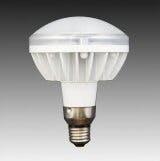The lamp uses a high-thermal-conductivity resin for the housing in place of aluminum. The resin is made by combining Teijin’s Raheama(tm) high-thermal-conductivity carbon material with polycarbonate resin.
The new lamp weighs just 300 grams, the same as a conventional self-ballasted mercury-vapor lamp. For LED lamps, a high luminous flux usually requires heat to be dissipated by an aluminum lamp body, and weight becomes an issue. The challenge has been to develop a resin that can dissipate sufficient heat while enabling a lower-weight product.
With only a tenth of the power consumption of a conventional mercury-vapor lamp, the new lamp is brighter and lasts 40,000 hours, roughly seven times longer than a conventional lamp. While conventional self-ballasted mercury-vapor lamps are usually available in 3,100K (Ra58), the new product comes in a warm-colored 3,000K (Ra=80) model, and a white 6,500K (Ra=70) version.
Iwasaki says that the lamp offers "high design quality utilizing the unique texture of high thermal conductivity resin, which differs from the metal feeling. It still fits existing fixtures yet creates a new impression."
Iwasaki expects initial annual sales of 30,000 lamps, while developing more product variations. With the new product, the company aims to expand applications for lighted signs, makeshift installations, factories and indoor facilities that require the performance, as well as for professional use by architects and lighting designers.
Teijin says that it will further expand the market for its Raheama product in LED and other applications, aiming to sell several hundred tons annually by 2015. As the market further develops, the company hopes to increase production capacity in the future.







